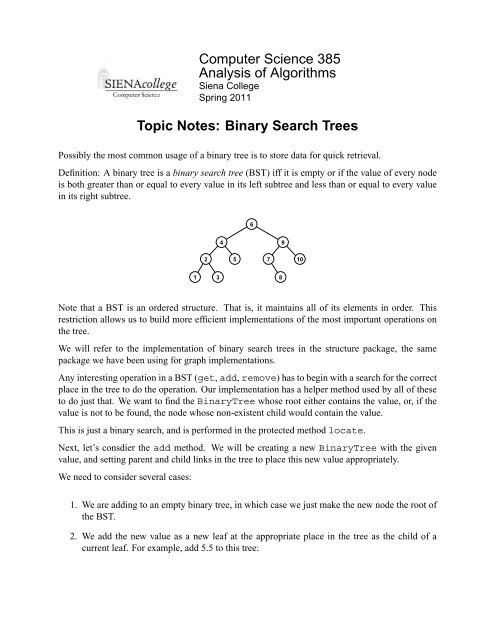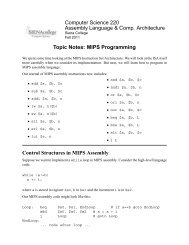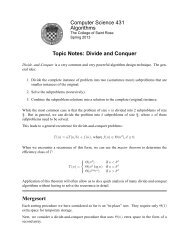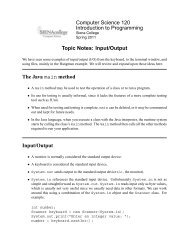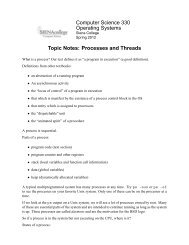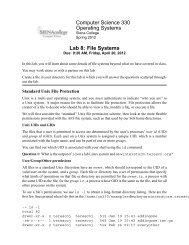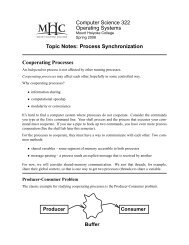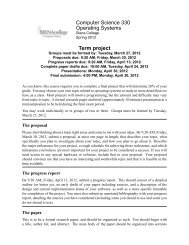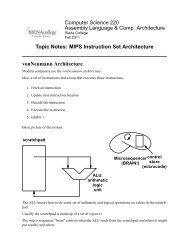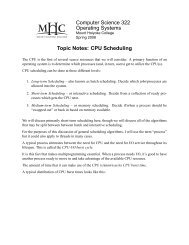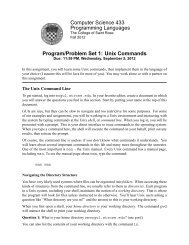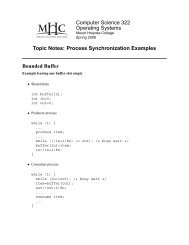Binary Search Trees - Courses
Binary Search Trees - Courses
Binary Search Trees - Courses
Create successful ePaper yourself
Turn your PDF publications into a flip-book with our unique Google optimized e-Paper software.
Computer Science 385Analysis of AlgorithmsSiena CollegeSpring 2011Topic Notes: <strong>Binary</strong> <strong>Search</strong> <strong>Trees</strong>Possibly the most common usage of a binary tree is to store data for quick retrieval.Definition: A binary tree is a binary search tree (BST) iff it is empty or if the value of every nodeis both greater than or equal to every value in its left subtree and less than or equal to every valuein its right subtree.649257101 38Note that a BST is an ordered structure. That is, it maintains all of its elements in order. Thisrestriction allows us to build more efficient implementations of the most important operations onthe tree.We will refer to the implementation of binary search trees in the structure package, the samepackage we have been using for graph implementations.Any interesting operation in a BST (get, add, remove) has to begin with a search for the correctplace in the tree to do the operation. Our implementation has a helper method used by all of theseto do just that. We want to find the <strong>Binary</strong>Tree whose root either contains the value, or, if thevalue is not to be found, the node whose non-existent child would contain the value.This is just a binary search, and is performed in the protected method locate.Next, let’s consdier the add method. We will be creating a new <strong>Binary</strong>Tree with the givenvalue, and setting parent and child links in the tree to place this new value appropriately.We need to consider several cases:1. We are adding to an empty binary tree, in which case we just make the new node the root ofthe BST.2. We add the new value as a new leaf at the appropriate place in the tree as the child of acurrent leaf. For example, add 5.5 to this tree:
CS 385 Analysis of Algorithms Spring 2011649257101 38to get649257101 3 5.583. If the value is one that is already in the tree, the search may stop early, in which case weneed to add the new item as a child of the predecessor of the node found.For example, adding 9 to the tree above:64925710135.589We can choose to add duplicate values as either left or right children as long as we’re consistent.Our implementation chooses to put them at the left.Our add implementation used a helper method predecessor. We have this, plus a helpermethod to find the successor.These are pretty straightforward. Our predecessor is the rightmost entry in our left subtree, and thesuccessor is the leftmost entry in the right subtree.The get method is very simple. It’s just a locate, followed by a check to make sure the valuewas found at the location.remove is more interesting.Again, there are a number of possibilities:1. We are removing a leaf, which is very straightforward.2
CS 385 Analysis of Algorithms Spring 20112. We are removing the root of the entire tree, in which case we need to change the root of theBST.3. We are removing an internal node, in which case we need to merge the children into a singlesubtree to replace the removed internal node.4. The item is not found, so the tree is unmodified and we return null.The implementation separates out three important cases: removing the root, removing a nodewhich is a left subtree, or removing a node which is a right subtree. In each case, we replace theremoved node with a tree equivalent to its two subtrees, merged together. This is accomplishedthrough the removeTop method.This method is also broken into a number of cases:1. Easy cases: If either child of top is empty, just use the other child as the new top. Done.2. Another easy case: top’s left child has no right child. Here, just assign top’s right to be theright child of left child and call the left child the new top.3. The more complex case remains: left child has a right child.Here, we will proceed by locating the predecessor of the top node, make that the new top,and rearrange the subtrees in the only way that retains the order of the entire tree.What about complexity of these operations?add, get, contains, and remove are all proportional to the height of the tree. So if the tree iswell-balanced, these are Θ(log n), but all are Θ(n) in the worst case.Tree SortOne of many ways we can use a BST is for sorting.We can build a BST containing our data and then do an inorder traversal to retrieve them in sortedorder. Since the cost of entering an element into a (balanced) binary tree of size n is log n, the costof building the tree is(log 1) + (log 2) + (log 3) + · · · + (log n) = Θ(n log n) compares.The inorder traversal is Θ(n). The total cost is Θ(n log n) in both the best and average cases.The worst case occurs if the input data is in order. In this case, we’re essentially doing an insertionsort, creating a tree with one long branch. This results in a tree search as bad as Θ(n 2 ).Balanced <strong>Trees</strong>3
CS 385 Analysis of Algorithms Spring 2011Just having the same height on each child of the root is not enough to maintain a Θ(log n) heightfor a binary tree.We can define a balance condition, some set of rules about how the subtrees of a node can differ.Maintaining a perfectly strict balance (minimum height for the given number of nodes) is often tooexpensive. Maintaining too loose a balance can destroy the Θ(log n) behaviors that often motivatethe use of tree structures in the first place.For a strict balance, we could require that all levels except the lowest are full.How could we achieve this? Let’s think about it by inserting the values 1,2,3,4,5,6,7 into a BSTand seeing how we could maintain strict balance.First, insert 1:1Next, insert 2:1\2We’re OK there. But when we insert 3:1\2\3we have violated our strict balance condition. Only one tree with these three values satisies thecondition:4
CS 385 Analysis of Algorithms Spring 2011It’s not completely obvious how to fix this one up, and we won’t worry about it just now. We doknow that after we insert the 7, there’s only one permissible tree:4/ \2 6/ \ / \1 3 5 7So maintaining strict balance can be very expensive. The tree adjustments can be more expensivethan the benefits.There are several options to deal with potentially unbalanced trees without requiring a perfectbalance.1. Red-black trees – nodes are colored red or black, and place restrictons on when red nodesand black nodes can cluster.2. AVL <strong>Trees</strong> - Adelson-Velskii and Landis developed these in 1962. We will look at these.3. Splay trees – every reference to a node causes that node to be relocated to the root of the tree.This is very unusual! We have a contains() operation that actually modifies the structure.This works very well in cases where the same value or a small group of values are likely tobe accessed repeatedly.We may talk more later about splay trees as well.AVL <strong>Trees</strong>We consider AVL <strong>Trees</strong>, developed by and named for Adelson-Velskii and Landis, who inventedthem in 1962.Balance condition: the heights of the left and right subtrees of any node can differ by at most 1.To see that this is less strict than perfect balance, let’s consider two trees:5/ \2 8/ \ /1 4 7/36
CS 385 Analysis of Algorithms Spring 2011After an insert, the subtree X increases in height by 1:k2k1XYZlevel nlevel n−1level n+1So now node k 2 violates the balance condition.We want to perform a single rotation to obtain an equivalent tree that satisfies AVL.Essentially, we want to switch the roles of k 1 and k 2 , resulting in this tree:k1k2XYZlevel nFor this insertion type (left subtree of a left child – case 1), this rotation has restored balance.We can think of this like you have a handle for the subtree at the root and gravity determines thetree.If we switch the handle from k 2 to k 1 and let things fall where they want (in fact, must), we haverebalanced.Consider insertion of 3,2,1,4,5,6,7 into an originally empty tree.Insert 3:38
CS 385 Analysis of Algorithms Spring 2011Insert 2:3/2Insert 1:3 2/ / \2 ---> 1 3/1Here, we had to do a rotation. We essentially replaced the root of the violating subtree with theroot of the taller of its children.Now, we insert 4:2/ \1 3\4Then insert 5:2/ \1 3
CS 385 Analysis of Algorithms Spring 2011Now insert 6:2
CS 385 Analysis of Algorithms Spring 2011k2k1XYZlevel nlevel n−1But now, our inserted item ends up in subtree Y :k2k1level nXYZlevel n−1level n+1We can attempt a single rotation:k1k2Xlevel n−1YZlevel nlevel n+1This didn’t get us anywhere. We need to be able to break up Y .We know subtree Y is not empty, so let’s draw our tree as follows:11
CS 385 Analysis of Algorithms Spring 2011k3k1level nABk2CDlevel n+1level n−1Here, only one of B or C is at level n + 1, since it was a single insert below k 2 that resulted in theAVL condition being violated at k 3 with respect to its shorter child D.We are guaranteed to correct it by moving D down a level and both B and C up a level:k2k1k3ABCDlevel nWe’re essentially rearranging k 1 , k 2 , and k 3 to have k 2 at the root, and dropping in the subtrees inthe only locations where they can fit.In reality, only one of B and C is at level n – the other only descends to level n − 1.Case 3 is the mirror image of this.To see examples of this, let’s pick up the previous example, which had constructed a perfectlybalancedtree of the values 1–7.4/ \2 6/ \ / \1 3 5 7At this point, we insert a 16, then a 15 to get:12
CS 385 Analysis of Algorithms Spring 20114/ \2 6/ \ / \1 3 5 7\16/15Node 7 violates AVL and this happened because of an insert into the left subtree of its right child.Case 3.So we let k 1 be 7, k 2 be 15, and k 3 be 16 and rearrange them to have k 2 at the root of the subtree,with children k 1 and k 3 . Here, the subtrees A, B, C, and D are all empty.We get:4/ \2 6/ \ / \1 3 5 15/ \7 16Now insert 14.4/ \2 6/ \ / \1 3 5 15/ \7 16\14This violates AVL at node 6 (one child of height 0, one of height 2).This is again an instance of case 3: insertion into the left subtree of the right child of the violatingnode.So we let k 1 be 6, k 2 be 7, and k 3 be 15 and rearrange them again. This time, subtrees A is the 5,B is empty, C is the 14, and D is the 16.13
CS 385 Analysis of Algorithms Spring 2011The double rotation requires that 7 become the root of that subtree, the 6 and the 15 its children,and the other subtrees fall into place:4/ \2 7/ \ / \1 3 6 15/ / \5 14 16Insert 13:4/ \2 7/ \ / \1 3 6 15/ / \5 14 16/13What do we have here? Looking up from the insert location, the first element that violates thebalance condition is the root, which has a difference of two between its left and right child heights.Since this is an insert into the right subtree of the right child, we’re dealing with case 4. Thisrequires just a single rotation, but one done all the way at the root. We get:7/ \4 15/ \ / \2 6 14 16/ \ / /1 3 5 13Now adding 12:7/ \4 15/ \ / \14
CS 385 Analysis of Algorithms Spring 20112 6 14 16/ \ / /1 3 5 13/12The violation this time is at 14, which is a simple single rotation (case 1):7/ \4 15/ \ / \2 6 13 16/ \ / / \1 3 5 12 14Inserting 11:7/ \4 15/ \ / \2 6 13 16/ \ / / \1 3 5 12 14/11Here, we have a violation at 15, case 1, so another single rotation there, promoting 13:7/ \4 13/ \ / \2 6 12 15/ \ / / / \1 3 5 11 14 16(Almost done)Insert 10:15
CS 385 Analysis of Algorithms Spring 20117/ \4 13/ \ / \2 6 12 15/ \ / / / \1 3 5 11 14 16/10The violator here is 12, case 1:7/ \4 13/ \ / \2 6 11 15/ \ / / \ / \1 3 5 10 12 14 16Then we finally add 8 (no rotations needed) then 9:7/ \4 13/ \ / \2 6 11 15/ \ / / \ / \1 3 5 10 12 14 16/8\9Finally we see case 2 and do a double rotation with 8, 9, and 10 to get our final tree:7/ \4 13/ \ / \2 6 11 15/ \ / / \ / \1 3 5 9 12 14 16/ \8 1016
CS 385 Analysis of Algorithms Spring 2011This tree is not strictly balanced – we have a hole under 6’s right child, but it does satisfy AVL.You can think about how we might implement an AVL tree, but we will not consider an actualimplementation. However, AVL insert operations make excellent exam questions, so keep that inmind when preparing for the final.The whole point of considering AVL trees is to maintain a reasonable balance, and hopefully, atree height that looks like log n. We will not do a detailed analysis, but the height n of an AVL treeis guaranteed to satisfy the inequality:⌊log 2 n⌋ ≤ h < 1.44.05 log 2 (n + 2) − 1.3277.We have log factors on both sides, leading to Θ(log n) worst case behavior of search and insertoperations.17


